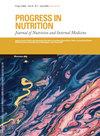Malnutrition rate among hospitalized patients with type 2 diabetes mellitus
4区 医学
Q4 Agricultural and Biological Sciences
引用次数: 15
Abstract
Aim: Rate of obesity is high among patients with type 2 diabetes thus assessment of the nutritional status is often ignored in these patients. This study aimed to evaluate nutritional status of patients with type 2 diabetes mellitus who were hospitalized forpoor glycemic control and to define the risk factors related to malnutrition. Methods: Study included a total of 104 patients (67 female, 37 male, mean age: 65.08±12.57) who were hospitalized in the Internal Medicine Clinics for poor glycemic control. Patients’ nutritional status was evaluated on the first day of admission. Demographic, anthropometric and biochemical data of the cases were evaluated. Nutritional status was assessed with Mini Nutritional Assessment(MNA) test. Results: Malnutrition rate was 7.7%, rate of the patients with malnutrition risk was 18.3% and rate of the patients with normal nutritional status was found as 74%. Body mass index was 25 kg/m2or higher in 37.5% of the patients with malnutrition and 63.2% in patients with malnutrition risk. In logistic regression analysis, duration of diabetes [(between 15-20 years OR: 5.535 (95% CI:1.15-26.61), >20 years OR: 7.147 (95% CI:1.59-31.96)] and BMI[<25 kg/m2 OR: 4.565 (95% CI:1.47-14.13)] were the independent risk factors correlated with malnutrition. Conclusions: One in every four patients with type 2 diabetes hospitalized due to poor glycemic control was observed to have malnutrition or have malnutrition risk indicating nutritional assessment should be performed in hospitalized patients with type 2 diabetes even if they are overweight or obese.2型糖尿病住院患者的营养不良率
目的:2型糖尿病患者的肥胖率很高,因此对这些患者营养状况的评估往往被忽视。本研究旨在评估因血糖控制不佳而住院的2型糖尿病患者的营养状况,并确定与营养不良相关的危险因素。方法:研究纳入了104名因血糖控制不佳而在内科诊所住院的患者(67名女性,37名男性,平均年龄:65.08±12.57)。入院第一天对患者的营养状况进行评估。对病例的人口学、人体测量和生化数据进行了评估。营养状况采用迷你营养评估(MNA)测试进行评估。结果:营养不良发生率为7.7%,有营养不良危险的发生率为18.3%,营养状况正常者发生率为74%。37.5%的营养不良患者和63.2%的营养不良风险患者的体重指数为25kg/m2或更高。在逻辑回归分析中,糖尿病持续时间[(15-20年OR:5.535(95%CI:1.15-26.61),>20年OR:7.147(95%CI:1.59-31.96)]和BMI[<25 kg/m2 OR:4.565(95%CI:1.47-14.13)]是与营养不良相关的独立危险因素。结论:每四名因血糖控制不佳而住院的2型糖尿病患者中就有一人营养不良或有营养不良风险,这表明即使超重或肥胖,也应对住院的2号糖尿病患者进行营养评估。
本文章由计算机程序翻译,如有差异,请以英文原文为准。
求助全文
约1分钟内获得全文
求助全文
来源期刊

Progress in Nutrition
医学-营养学
CiteScore
1.40
自引率
0.00%
发文量
0
审稿时长
>12 weeks
期刊介绍:
Progress in Nutrition was founded in 1999 as an independent magazine, a multidisciplinary approach, dedicated to issues of nutrition and metabolism.
 求助内容:
求助内容: 应助结果提醒方式:
应助结果提醒方式:


